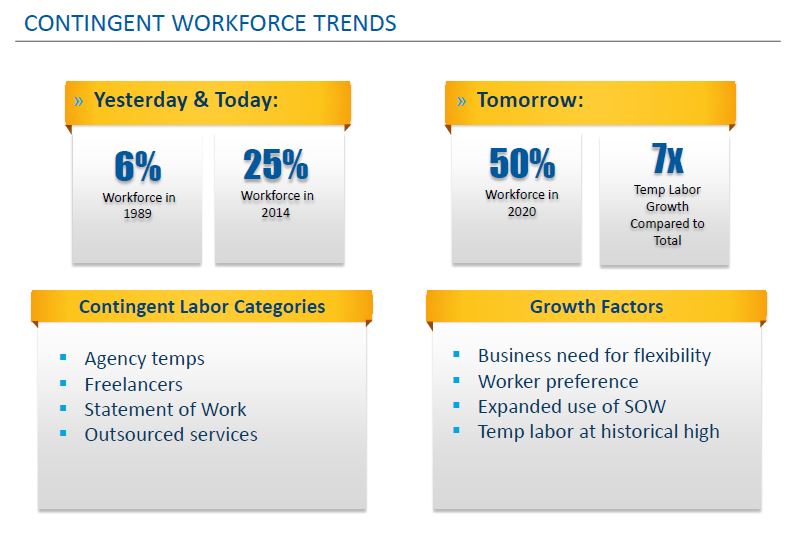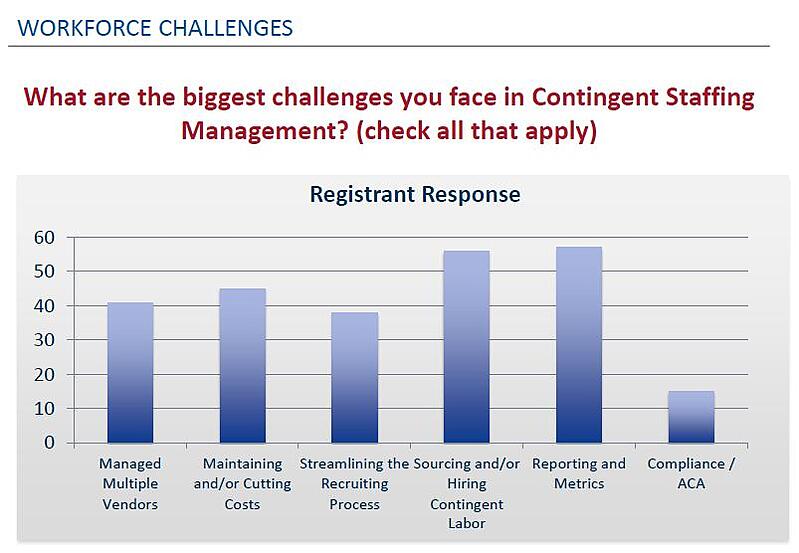 Let's face it. Self-managing contingent workers is becoming more labor intensive than ever. At the same time, companies no longer view contingent labor as "temps," but are leveraged for their cost saving and operational efficiencies.
Let's face it. Self-managing contingent workers is becoming more labor intensive than ever. At the same time, companies no longer view contingent labor as "temps," but are leveraged for their cost saving and operational efficiencies.
If you've managed contingent workers, then you know all too well the struggles that come with the job. As the use of contingent workers steadily rises, so do the challenges that accompany sourcing and hiring temp labor; not to mention the number of administrative, legal and managerial functions associated with this complex workforce.
There are a number of reasons an organization will struggle with whether to keep its contingent workforce program in-house or outsource it. Often times, the business case is viewed as the ultimate deciding factor that you are ready to bring on an outside provider. However, it's really just the starting point.
Bringing on a Managed Service Provider (MSP) to manage contingent workers is an important decision to make. As the person presenting the case, you want to be confident that you've covered all of your bases. For that reason, we are sharing these 3 fail proof steps to help you develop a business case for better contingent labor management.
Validate a Need
We hosted a live webinar with IQNavigator, a leading provider of Vendor Management Software (VMS) to identify exactly what goes into a contingent labor business case. But before starting any business case, you need to validate your need. This means going beyond your gut instinct and seeking out empirical data that supports your case.
Contingent Workers on the Rise
 Statistics provided by IQNavigator
Statistics provided by IQNavigator
As this webinar slide illustrates, there is a rising trend among contingent workers over the past 15 years. More specifically, during the live webinar, we highlighted some of the top reasons why the increased popularity of contingent labor exists.
- Staffing Industry Analyst reports that 16 percent of the American workforce today consists of temporary or contingent employees
- According to the BLS, the number of temporary workers jumped 8.5 percent from 2013 to 2014
- Enterprise organizations benefit from contingent workers because of the increased agility and cost savings they offer
By validating the need, you are building the foundation of your business case by justifying why you require additional resources.
Pinpoint Areas of Weaknesses
With the rise in demand, we thought that supply, or access to talent, would be a primary concern for webinar attendees. However, after polling the audience, we quickly realized this was not the main point of contention.
In fact, just above sourcing and hiring, the polled webinar attendees cited reporting and metrics as their biggest contingent staffing challenge. Which, for organizations self-managing their program, makes all the sense in the world.

Digital tools and platforms, like VMS technologies, have made hiring temporary talent turnkey. However, that's not to say managing the tools to manage the people is as seamless of a process.
Like any technology-based tool, there are a number of factors that contribute to leveraging it to its fullest capabilities. These tend to include one or more of the following:
- Having a dedicated team to actively manage the tool
- Budgeting training and technical resources
- Keeping up with the latest best practices and software updates
Sometimes, the business case comes crumbling down because there isn't enough emphasis placed on the full scope of resources needed to properly execute the plan.
Build A Business Case for a Real Person
Depending on where your company's resources fall flat will ultimately set the tone for the business case. To get your creative juices flowing, we've identified some key questions you should be sure to address in your business case for contingent labor management.
- Who in your organization are you building your business case for?
- What drives their decision making process?
- Are there any potential partners you can include and/or partner with now?
- If possible, include a projected road map to help illustrate the time line/next steps
Any solid business case should include some basics; including upcoming trends and threats within your industry, areas where you are currently weak or lack resources to stay competitive, and last, who within your organization makes decisions and how they go about doing so.
The best advice we can provide is to do as much research as you can inside and outside of your organization. Really wrap your hands around the landscape while being as objective as you possible can. Find out in advance who the decision makers are, and tailor your business case to address their most relevant and timely needs and concerns.



